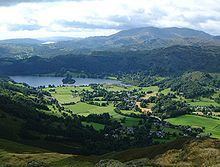OS grid reference NY335074 District South Lakeland Country England Area 62 ha | Civil parish Lakes Region North West Sovereign state United Kingdom Shire county Cumbria | |
 | ||
Weather 11°C, Wind W at 18 km/h, 88% Humidity Points of interest Dove Cottage, Easedale Tarn, Helm Crag, Rydal Mount, Helvellyn | ||
A trip to the lake district coniston windermere grasmere hawkshead ambleside
Grasmere is a village, and popular tourist destination, in the centre of the English Lake District. It takes its name from the adjacent lake, and is associated with the Lake Poets. The poet William Wordsworth, who lived in Grasmere for fourteen years, described it as "the loveliest spot that man hath ever found".
Contents
- A trip to the lake district coniston windermere grasmere hawkshead ambleside
- Map of Grasmere Ambleside UK
- Karen brown s white moss house grasmere england
- Etymology
- Geography
- Transport
- Rushbearing
- Grasmere Sports
- Grasmere Chocolate Cottage
- Grasmere gingerbread
- Religious
- Government
- Notable persons
- References
Map of Grasmere, Ambleside, UK
Before 1974, Grasmere lay within the former county of Westmorland, but today it is part of the county of Cumbria.
Karen brown s white moss house grasmere england
Etymology
" 'The lake flanked by grass'; 'gres', 'mere'. Early spellings in 'Grys-', 'Gris(s)-' might suggest ON 'griss' 'young pig' as 1st el.[ement], but the weight of the evidence points to OE/ON 'gres' 'grass', with the modern form influenced by Standard English....The medial '-s(s)e-' may, as suggested by Ekwall in DEPN, point to ON 'gres-saer' 'grass-lake' as the original name...". Plus the element "'mere' OE, ModE 'lake, 'pool'."
(OE is Old English, the language spoken until about AD 1100; ON is Old Norse.)
Geography
The village is on the river Rothay which flows into Grasmere lake, which lies about 0.5 km to the south. The village is overlooked from the NW by the rocky hill of Helm Crag, popularly known as The Lion and the Lamb or the Old Lady at the Piano. These names are derived from the shape of rock formations on its summit, depending on which side you view it from.
A number of popular walks begin in the village, including the ascent of Helm Crag, a longer route up to Fairfield and a moderate 200-metre ascent to Easedale Tarn. The village is also on the route of Alfred Wainwright's Coast to Coast Walk.
The A591 connects Grasmere to the Vale of Keswick over Dunmail Raise to the north, and Ambleside to the south. In other directions, Grasmere is surrounded by high ground. (As of Christmas 2015, the A591 was washed away on the Keswick side of Dunmail Raise, resulting in a long detour. It was reopened in May 2016.) To the west, a long ridge comes down from High Raise and contains the lesser heights of Blea Rigg and Silver How. To the east, Grasmere is bordered by the western ridge of the Fairfield horseshoe.
Transport
Grasmere is served by the Stagecoach 555 bus service which connects it with other towns in and near the Lake District such as Keswick and Lancaster. In summer it is served by an open top double-decker 599 service, operated by Stagecoach, which runs between Grasmere and Bowness-on-Windermere.
Rushbearing
Grasmere's famous Rushbearing Ceremony, centred on St Oswald's Church, has ancient origins. The present-day ceremony is an annual event which features a procession through the village with bearings made from rushes and flowers. In this procession there are also six Maids of Honour, a brass band, the church choir, and anyone who wishes to join in by carrying their own decorated rushbearing.
Grasmere Sports
The annual Grasmere Sports take place in August and were first held in 1852. This is the main event in the village's calendar and one of the most popular traditional events in the Lake District. Participants compete in a variety of sports, including Cumberland Wrestling, fell running and hound trails (similar to drag hunting).
Grasmere Chocolate Cottage
Grasmere is now home to the winner of the 'Get Started Award 2014' awarded by the Institute of Enterprise and Entrepreneurs, the Handmade Chocolate Shop.
Grasmere gingerbread
Today's Grasmere Gingerbread is made to a "secret recipe" popularised by Sarah Nelson (1815–1904). By the early nineteenth century, Grasmere gingerbread was already being sold as fairings, as well as being a popular seller in its own right. Poet Dorothy Wordsworth wrote in 1803 that she and her brother William craved for the gingerbread.
Religious
Until September 2013, Grasmere's three main church parishes (Catholic, Church of England and Methodist) gathered three times a year to celebrate mass in the Catholic Church of Our Lady of the Wayside.
Government
The former civil parish was for a time governed by an urban district council before becoming part of the Lakes UDC in 1934. The village is now part of Lakes Parish. Grasmere is currently represented by Liberal Democrat politicians on both the district council and county council, as well as at Westminster. Grasmere has experienced population decline since the 1960s.
Notable persons
In birth order:
